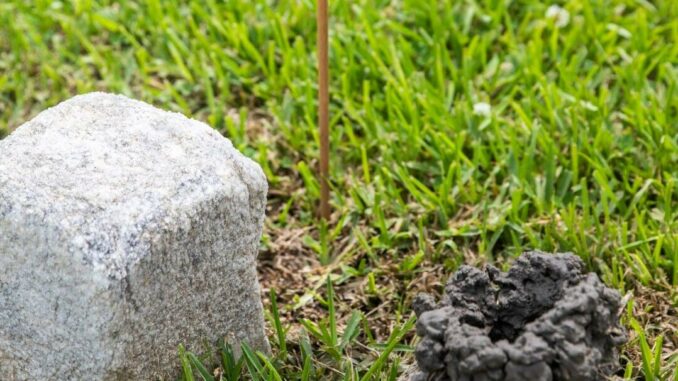
Garden columnist Dan Gill answers readers’ questions each week. To send a question, email Gill at gnogardening@agcenter.lsu.edu.
I have crawfish mounds popping up all over my yard. I can remove the mounds of soil, but is there any way to control the crawfish causing them? Frank
With all the rainy weather, crawfish activity has been high this spring. The crawfish that live in lawns and ditches are a different type than the crawfish we eat. The cylindrical mounds or “chimneys” they make can be a nuisance in lawns.
Here is information on control provided by Greg Lutz, aquaculture specialist with the LSU AgCenter. The crawfish that create holes and chimneys in landscapes spend their entire lives away from permanent water.
In the early spring, they leave their burrows for a few hours after heavy rainfalls and mate. Then, a few weeks later, the females lay their eggs, and after the next heavy rain, they will emerge again and turn their babies loose in large puddles and ditches.
The reason there are more inquiries about crawfish burrows in late spring/early summer is because they have just finished their spawning season and are back in the ground cleaning out and enlarging their burrows.
So, how to get rid of them? According to Lutz, one thing that seems to work is lye. Putting about one tablespoon of lye in the burrows usually does the job. And as it migrates through the surrounding soil it turns into harmless by-products.
When using lye, remember that it is caustic. Be sure to wear hand and eye protection and protective clothing when applying lye. It is used in making homemade soap and may be available where soap making supplies are sold. It is readily available online.
I am having a problem with mushrooms growing in my vegetable garden. For each one I dig up, it seems like I get two or three in its place. They’re white and black. How do I get rid of these pesky mushrooms without hurting my vegetables? Violet
Other than irritating you, the mushrooms are not causing a problem. Feel free to collect and remove them as you see them or simply ignore them, as they don’t hurt anything.
There are no fungicides that you could use in this situation to control the fungi producing the mushrooms The fungal organisms decay organic matter and are living off the organic matter you dug into the soil and/or the mulch. They are not attacking or hurting the vegetables, and, as they decay the organic matter, they benefit the vegetables growing in your garden.
I have black powdery spots appearing on my lawn. I’m concerned they are hurting the grass and want to know how to get rid of them. Donna Broussard
What you are seeing are slime molds. These organisms are harmless to the grass and live in the lawn year-round decaying organic matter, something that benefits the lawn by preventing the buildup of thatch.
During the late spring and summer they enter a reproductive phase when they produce spores. During this phase, the slime mold grows up onto the blades of grass and produce spores there (this does not damage the grass). The growth starts out gray, but as the black spores mature the area turns black.
Eventually the slime mold growth disappears, and the healthy grass remains. If the spots bother you, you can wash off the spores with a strong stream of water from your garden hose as a patch appears.
Since the condition is harmless, no treatment is recommended or needed. Slime molds of various colors (red, yellow, orange, white) may appear in garden beds. Again, they are harmless and there is no need for concern.
Leaf-footed bugs create yellow spots on ripe tomatoes by piercing tissue with needle-like mouthparts and sucking out the juices.
Garden tips
TOMATO PESTS: Insects with orange bodies and long black legs clustered on tomatoes or vegetable plants are nymphs (immature stage) of leaf-footed bugs. When they grow up, they will be brown. They have sucking mouthparts and can damage tomatoes, causing yellow spots on the ripe fruit. Vacuum them off with a hand-vac or spray plants with permethrin.
OUT WITH THE COLD: Most of the cool-season vegetables still lingering in the garden should be cleared out this month. As they are removed, rework beds and plant heat-tolerant vegetables (such as okra, peanuts, Southern peas) for production during the summer.
WATER WHERE? During dry weather, don’t forget to occasionally water your compost pile to keep it moist. Dry organic matter will not break down. Sometimes it is helpful to shove the hose into the compost pile to make sure water reaches the inner parts.
FEED CONTAINER PLANTS: Apply a slow-release fertilizer to your container plants outside to keep them well fertilized through the growing season. One application will fertilize for many months, saving you time and effort.
BIRD DAMAGE: Birds will peck holes in tomatoes just before you decide they are ripe enough to harvest. If birds are a problem, cover your plants with bird netting or harvest the fruit in the pink stage and ripen them inside. Bird netting also works well to protect fruit crops, such as strawberries, blackberries, blueberries and figs, and is available from local nurseries or feed stores.

Leave a Reply